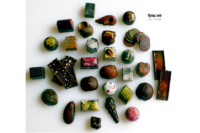

I am always intrigued by situation. That, for me, is where each of my five novels has always begun. And what better situation is there than a candy factory in crisis? Who would these people be? What is the true story of this family candy business entering its fourth generation? What are their secrets? What would be their dilemmas, what is at stake for each of them, and then what happens? It seemed like such rich territory.
Everyone loves candy, and everyone is curious about how it’s made, and everyone has such an emotional response to the candy of childhood, especially. So it seemed like a wonderful world in which to locate my story, which, in turn, became very much about this world. I think I fabricated “True Confections” the way you set about dreaming up a complex combination bar, aiming for those irresistible surprising contrasts of salty and sweet, crunch and goo, irresistible sweetness and chewy texture with a particular nutty flavor that lingers long after you have swallowed the final morsel.
How did you go about educating yourself?
I began to read histories of chocolate, histories of sugar, histories of the confectionary business - and in each I found threads for my story and areas of particular interest, not all of which I could pursue. I read many books about small businesses, with special focus on the issues that inevitably arise in successor generations in a family business. And I love the infinity of information one can find on the Internet. Candy company Web sites, candy blogs, the stories and counter-stories that tell the histories of certain brands, their relationships to troubling issues of racial stereotyping in the past - all of these were incredibly inspiring as I went about creating my own family candy business, Zip’s Candies, owned and operated by the Ziplinsky family since 1924 in New Haven, Conn., where they have made their three signature candies (Little Sammies,Tigermelts andMumbo Jumbos, all inspired by the problematic Little Black Sambo) all these years. (Visit Zip’s Candy’s atwww.zipscandies.com.)
And with (genuine) journalism assignments and press credentials, I attended theAll Candy Expoin Chicago twice, in 2008 and 2009, where I learned an enormous amount about so much every single hour I was at the show, both years. I had so many valuable conversations with so many people from so many candy companies - from Mitch Goetze of Goetze’s to Arthur Shorin of Topps to Tom Joyce of Hershey to Deborah Schimberg of Glee Gum and dozens more. There are key scenes in “True Confections” that take place at All Candy and at a fictional New York show at the Javits Center I named Candycon.
How has the candy industry received your book?
I have been immensely gratified that Susan Karl, ceo of Annabelle Candy, thinks I got it right, from the issues in a family business (though I hasten to add that Zip’s Candies is not based on Annabelle or any other actual company, though my fictional company is also headed by a woman) to my descriptions of the mechanical workings of a small candy factory, though I had never set foot in one until my visit to Annabelle Candy last week when I was in the Bay Area to speak about “True Confections” at Kepler’s Books in Menlo Park. The bookstore event consisted of a conversation with Susan about the candy business in fiction and in fact, and the happy crowd got generous free samples ofBig Hunk,Look,U-No,Rocky RoadandAbba-Zaba.
I have also heard from Ross Born, who was very helpful to me when I was writing (whether he knew it or not) on the subject of family dynamics in business, who is reading it now. Susan Smith of the National Confectioner Association has written on the NCA blog (www.candydishblog.com) about “True Confections” in a very perceptive and knowing way, as have a few candy bloggers, such as the very scholarly and thorough Candy Professor (www.candyprofessor.com), and then there’sCandy Industry! I am really excited that candy people are discovering my novel, through mainstream press reviews (which have been fabulous - people love candy and love writing about candy, including book critics) and through this kind of wonderful industry attention, for which I am very grateful.
What’s your favorite candy?
I think my heart belongs toBaby Ruth. Though when I am in Ireland I am partial to theLion Bar. And I do have a passion forGreen & Black’sfabulous White Chocolate Bar, which actually figures in “True Confections.”
What’s next for you, writing-wise?
I am finishing up a memoir about family stories and considerations of the narrative impulse called “Symptoms of Fiction,” and after that I have three novels in my head, which I will write one by one in the next few years. I am pretty sure, meanwhile, that I am not quite done writing about candy. There will be candy in these novels.
Editor’s Note: In addition to writing “True Confections,” Katharine Weber has authored four other novels: “Triangle,” “The Little Women,” “The Music Lesson” and “Objects in Mirror Are Closer Than They Appear.” She lives in Connecticut with her husband, cultural historian Nicholas Fox Weber, and is a thesis adviser for the graduate writing program at Columbia University. For more information, visit www.katharineweber.com.







